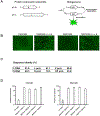Development of reverse genetic tools to study Chapare and Machupo viruses
- PMID: 37774602
- PMCID: PMC11539271
- DOI: 10.1016/j.virol.2023.109888
Development of reverse genetic tools to study Chapare and Machupo viruses
Abstract
Arenaviruses are highly pathogenic viruses that pose a serious public health threat. Chapare virus (CHAV) and Machupo virus (MACV), two New World arenaviruses, cause hemorrhagic fevers with case fatality rates of up to 45%. Research on therapeutic drug targets and vaccines for these viruses is limited because biosafety level 4 containment is required for handling them. In this study, we developed reverse genetics systems, including minigenomes and recombinant viruses, that will facilitate the study of these pathogens. The minigenome system is based on the S segment of CHAV or MACV genomes expressing the fluorescent reporter gene ZsGreen (ZsG). We also generated recombinant CHAV and MACV with and without the ZsG reporter gene. As a proof-of-concept study, we used both minigenomes and recombinant viruses to test the inhibitory effects of previously reported antiviral compounds. The new reverse genetics system described here will facilitate future therapeutic studies for these two life-threatening arenaviruses.
Keywords: Antiviral; Arenaviruses; Chapare virus; Hemorrhagic fever; Machupo virus; Reverse genetics.
Published by Elsevier Inc.
Conflict of interest statement
Declaration of competing interest The authors declare that they have no known competing financial interests or personal relationships that could have appeared to influence the work reported in this paper.
Figures



References
-
- Albariño CG, Wiggleton Guerrero L, Lo MK, Nichol ST, Towner JS, 2015. Development of a reverse genetics system to generate a recombinant Ebola virus Makona expressing a green fluorescent protein. Virology 484, 259–264. - PubMed
-
- Ambrosio AM, Riera LM, Saavedra Mdel C, Sottosanti MJ, 2005. [Preclinical assay of candid #1 vaccine against Argentine Hemorrhagic Fever made in Argentina]. Medicina 65, 329–332. - PubMed
Publication types
MeSH terms
Grants and funding
LinkOut - more resources
Full Text Sources
Other Literature Sources
Research Materials

